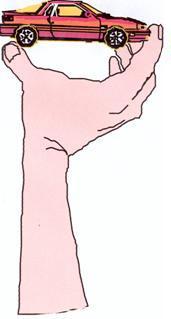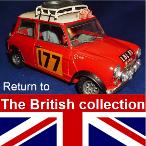
Morris Minor 1958-62
Two cars roll on British roads that are almost universally recognised and loved. The Morris Minor and the “Mini” Minor. Both the Minor and the Mini were designed by Sir Alec Issigonis and they are proof that the Issigonis mantra of “Space for passengers and payload, not mechanicals” appealed to the burgeoning throng of car owners with minimal mechanical knowledge but growing ambitions to be treated on equal terms as the upper classes, those who enjoyed the freedoms of motoring simply because they could afford it. It probably never occurred to Issigonis that either of these cars would be purchased and loved just as much by the rich and famous as they were buy the man in the street.
While Issigonis and his team would later goon to the greater feat of engineering the “Mini”, Sir Alec’ was most proud of the Morris Minor.
On the 27th of October 1948 the new Morris Minor was presented to the world at the British Motor Show at Earls Court in London. A starting price of £358 was all that was needed to purchase a new two-door saloon or for a little more a two-door tourer model could be had. Issigonis' ideas and designs could also be found on the company’s other new vehicles launched at the show. New 1.5 litre Morris Oxford and 2.2 litre Morris Six models, and more upmarket Wolseley badged versions of the same cars, were in many ways scaled up minor variants. The star though was still the little Morris Minor, a revolutionary and cutting-edge design that was shaming the rest of Europe’s economy cars which were mostly still using pre-war engineering. Just to be clear there wasn’t an upmarket Wolseley version of the Minor but a prototype Wolseley Minor, and even an MG prototype, was built.
More than half a million people came to the show, some searching for a chance to enjoy the joys of motoring that wartime experiences had given, other out of simple interest and yet others looking to temper the monotony of life in the austerity and rationing that was post war life. The spacious Morris Minor, that could stretch the petrol ration a little further and was within the reach of so many more people, was dubbed “the show sensation” by Motor magazine; the car was a hit with the public and press alike. If the Jaguar XK120 was the epitome of chic stylishness, then the Morris Minor was the British “people’s car”. Despite its bulbous nose and split windscreen this was a car people could actually aspire to own. The original MM series ran from September 1948 to February 1953 featuring just the 2-door saloon and convertible models until the four-door saloon was added in 1950.
Austin-Morris
World war two may have been a victory for Britain and its European allies but the financial costs were crippling. Destroyed factories, material shortages, lack of money and Government imposed export requirements (to obtain permission to buy steel) strained all the motor car manufacturers and Morris was no exception. So it was that Morris, under Nuffield Organisation (which also included MG, Riley and Wolseley), and their most hated competitors, Austin, ended up combining their companies in order to remain in business. The new British Motor Corporation (BMC) now had competing lines under the same umbrella and two work forces determined not to get along with each other. The Austin 'Seven' series was set against the Morris Minor range, but, there was a silver lining to this situation; Morris now had access to Austin’s 803cc 'A-series' overhead valve 4cyl’ engine. This power unit might have had a smaller displacement, but it produced more speed for the Morris Minor. The new acceleration figure for 0 to 50mph was 28 seconds and top speed was 63mph. Still not a startling acceleration figures but an improvement all the same, adding to the fun factor with its livelier engine.
This was the start of the Morris Minor Series II models which were strongly advertised with phrases like "New Power for The Minor".
The Morris Minor 1000 series (1956 to 1971).
The car that became the much-loved Morris Minor 1000 arrived in October 1956. Soon to become a favourite as an economical second car for the wife to run around in the Minor 1000 was a radical transformation of the MM. Thoroughly modernized and all together more solid and user friendly it also became increasingly popular in the United States.
The split screen was swapped out for a larger one-piece front windscreen and the rear window became bigger too. There was an overlapping period were the previous clap-hands windscreen wiper system of the split screen cars remained in service until eventually moving to the now conventional pairing system. all round visibility was excellent, in the dry at least. Other visible differences include smaller rear wheel cut outs, larger front side-light/indicator and rear-light/indicator combo’s. New “Minor 1000” logos for the bonnet sides and the boot lid.
On the inside the dashboard layout was upgraded with one, or even two, lids for the glove boxes, not that the one on the driver’s side was actually helpful! The steering column was redesigned to house the indicator stalk rather than the earlier, slightly awkward, switch under the dash arrangement. A new heater was fitted with a different frontage and the more modern two spoke black steering wheel replaced the dished wire spoke one. Other changes included the gear lever and handbrake being reduced in size, the gear lever moved backwards and the handbrake moved forwards to make a more ergonomically correct layout.
The Minor 1000 title was marking the new version of the A series engine now being installed. 948cc of inline four-cylinder engine provided 37hp @ 4,750 rpm. At the same time a new gearbox was also fitted and suddenly the nimble little car was quite nippy too. Being able to maintain higher speeds was not only a boon on the new British Motorways but the Americans with their long freeways and expanse of space found the particularly appealing.
As a matter course the Minor 1000 was constantly being improved. Fuel capacity was increased in March 1957 with a larger six-and-a-half-gallon tank replacing the old five gallon’ one. It did push its way into the boot space a little but journeys could now be extended and worrying about the fuel level was a little less urgent. The ride was softened by reducing the rear springs from seven to five leaf units; although this did have a less than positive effect on the cars handling characteristics. Around this time the Traveller got a roof upgrade in that a canvas roof lining took the place of the earlier Rexine board. Convertible’s, on the other hand went from having canvas hoods to having ones made of plastic!
In 1959 the interior was the centre of attention a wider parcel shelf fitted under the dash’ and the horn button was relocated to a much more convenient position in the centre of the steering wheel. Indicator stalks became self-cancelling and had a large green repeater bulb on the end of the stalk. I a small upgrade of the exterior all road wheels and grills were painted pearl grey. 1959 proved to be the best year for sales in the U.S.A., a total of 14,991 being sold in America alone.
The landmark moment for the Minor 1000 was the production of the millionth Minor. Rolling of the production line at Cowley, on the 22nd of December, 1960, a 2-door saloon, in King's Road lilac, made the Minor the first British car to reach this level of production. Such an achievement deserved to be celebrated and Morris decided a run of commemorative replicas of this millionth Minor should be made. 349 additional special cars, painted “Minor Millions Lilac” and featuring white upholstery, went onto the market, a good amount of which survive to this day. A final total of 350 “1,000,000th” Minors were produced; why 350? One for each Morris dealership in the UK. One special, but unobtrusive change was the bonnet and boot lid badges which for this run read "Minor 1,000,000" in place of the regular Minor 1000 logos.
As part of the promotional campaigns Morris donated the millionth Minor to the National Union of Journalists to be a competition prize to raise money for the union's Widow and Orphan Fund. Morris also provided a celebratory Minor for the Great Ormond Street Hospital for Sick Children in London. This one was even more special though; it was made out of cake.
Evolutionary changes continued through the Minors life. In 1961 the semaphore type trafficators were replaced by modern flashing indicators. These were combined into new larger lighting units front and rear, the front combined the side lights and indicators, the rear as one cluster in which the indicators made up about a third of the unit so the new rear lights are a third as big again as the out ones. Two-tone Vynide upholstery replaced leather on the deluxe range, standard range was the same but in single colour. In another odd reversal the lids for the glove boxes were dropped leaving open storage again.
More than 1.6 million Morris Minors, in all its variants, were produced in a production run of over two decades between 1948 and 1971. This figure includes 269,838 Series II cars and nearly 850,000 Minor 1000s.
In hindsight, this end for the Minor 1000 might also be seen as coinciding with the beginning of the end for the traditional British motor. Poor labour relations, tragically bad quality and ineffectual management was endemic in the British Motor industry, try as it might to update itself the industry was killing itself from within and the beloved, quintessentially English, Minor, would be the last of its generation, and, along with the other Issigonis miracle car, the Mini, the last British car to be so affectionately remembered the world over.













Although there have been many models of the Minor from diecasts, toys, and scale model kits for some reason a 1/24th scale version has never been made on a mass production level. This model started as just a resin body shell purchased by Ian, for Rod, in 2015. It disappeared into his collection but resurfaced during 2017. Rod then did a lot of scratch building and between Rod and Ian the body was totally reworked and a full resin model kit produced. The first prototype model kit proved over complicated and was reworked through 2018 before going way to be professionally moulded and cast in resin.
Kit # MMiM 124001 this kit was the first model kit released by us, the Motor Museum in Miniature. In cooperation with Coastal Craft and their new range of “Race Craft” kits the Morris Minor kit went on sale at the 2018 IPMS (UK) Scale Model World show.
The model is finished with a custom mix of Deco-Art paints and Zero paints clear lacquer. Humbrol enamels and acrylic paints from Citadel and Deco-Art have been used for the interior and detail painting. Bare metal foil has been used on the chrome work along with Molotow liquid chrome pens for the smaller parts. This model is exactly what you get in the box.
Ian built this model in early 2019 for our friends at Coastal Craft as their display piece and now resides with Martin Blundell.
RETURN TO :-
